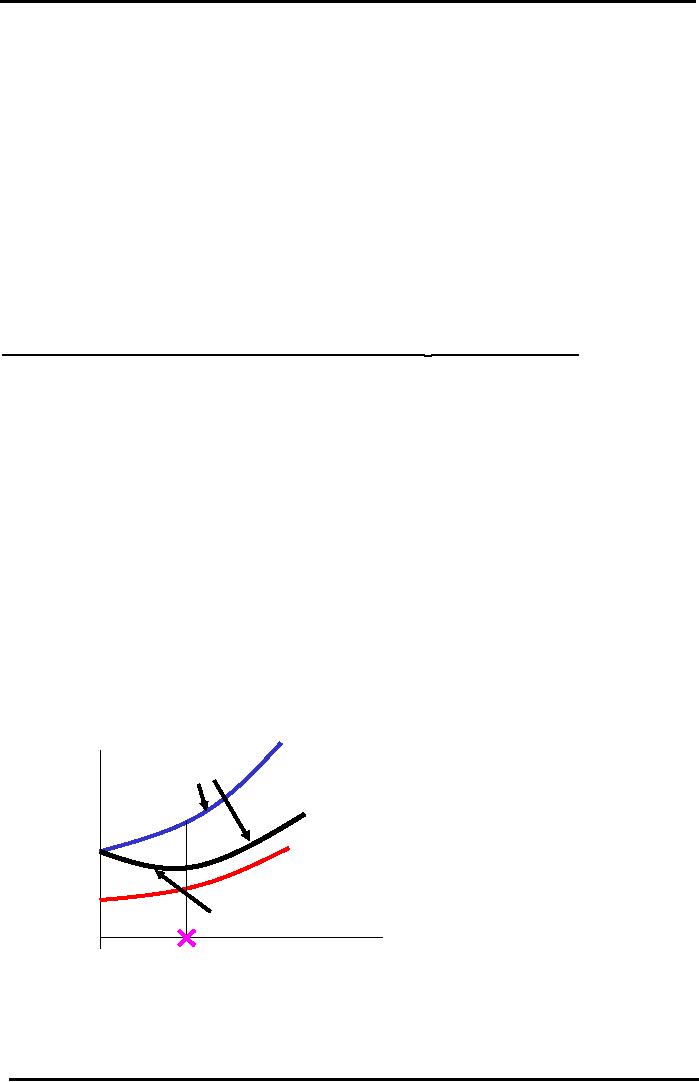 |

Financial
Management MGT201
VU
Lesson
35
NET
INCOME AND TAX SHIELD APPROACHES TO
WACC.
Learning
Objectives:
After
going through this lecture,
you would be able to have an
understanding of the following
topic:
�
Net
Income & Tax Shield Approaches to
WACC
In
the last lecture we discussed the impact
of debt on firm value under
Miller Modigliani approach
in
detail with numerical examples. We
also discussed the formulae to
see the impact of debt on
firm
value
under traditionalist real
market concepts. Now we
continue the same discussion
with the help of
an
example under traditionalist
real market views:
Traditionalists
-Real Markets
Example:
The
following example will help
to understand how we can calculate WACC
for a firm in the
real
world:
A
100% Equity Firm (or
Un-levered) has Total Assets
of Rs.1000. It has a WACCU of
21% and
rD,U of
10%. It then adds Rs.400 of
Debt. Financial Risk
increases rD,L of
Levered Firm to 13%. What
is
the
Levered Firm's rE,L and WACCL
? Tax rate is
30%.
Debt
rD(Interest)
rE
EBIT
NI
Equity
Market
Value WACC
(Given
D)
(Given)
(Given)
(Rs.)
(Rs.)
(E=NI/ rE)
(=D+E)
(%)
Rs.0
(=V)
0
21%
300
210
Rs.1000
Rs.1000
21%
Rs.200
10%
(rRF)
22%
300
189
Rs.859
Rs.1059
17.9%
Rs.300
11%
23%
300
187
Rs.813
Rs.1113
16.8%
Rs.400
13%
28%
300
183
Rs.653
Rs.1053
17.4%
Rs.500
14%
33%
300
179
Rs.541
Rs.1041
17.2%
�
Un
levered Case: D=0 ,
rE
= 21%
= WACC,
Market
value of Equity = E = V = Market
value of Firm (due to no
debt) = Rs1000
�
Leverage:
Debt
(and Leverage) is gradually increasing
from Rs.200 to Rs.500. Change
in
Leverage
Changes the Firm's Value.
When Debt = Rs.400 value of
firm has Increased to
Rs.1053
under traditionalist view
whereas we assumed firm
value fixed at Rs.1000 in Pure
MM
Ideal
Market Example. Rise in
value of firm is due to interest
savings.
�
Optimal
Capital Structure occurs
at Debt of Rs.300
(i.e.
xD = D / V = Rs.300 / Rs.1113 =
0.2695). So a Financial Leverage of
26.95% is the Best
Capital
Structure for this Firm.
Here, WACC = 16.8% and value
of the firm at its highest
=
Rs.1113.
�
After
this point value of firm
starts falling and WACC
rising.
Traditionalist
View - Real Markets
Bankruptcy
Risk
&WACC
Graph
Cost
of
Costs.
Higher
Required
Return on
Capital
rE,L =
Cost of Equity =
Equity.
Steeper Rise.
(%)
WACCU +
xD(WACCU
-rD)
(1-TC)
WACCL =
rD(1-Tc)xD +
rExE
rE
rD =
Cost of Debt
rD
Interest
Tax Shield
Advantage
Debt
/ Equity =
100%
Optimal
Capital
Measure
of Leverage
Equity
Structure
Firm
D/E
= xD / ( 1- xD
)
Minimum
WACC &
Note:
xD = D / (D+E)
Maximum
Market Value
151

Financial
Management MGT201
VU
Here
cost of equity for a levered
firm rises very fast. Also
cost of debt rises. Recall
we have studied this
graph
earlier in previous lectures. Here
point to note is that WACC
line has become curve
with a
minimum
point at its lowest.
Initially it comes down as it
moves away from Y-axis and
then after
reaching
its minimum it starts going
up. The minimum point at
WACC is the best optimal
point for firm
to
operate for it capital structure.
Traditionalists
- Real Markets Effect of Leverage on
WACC:
�
Interest Tax Savings Increase,
Cost of Interest or Mark-up
Increases, and Cost of
Equity
Increase.
Depending on the Rate of Increase, they
can affect computation of
Firm's Market
Value
(V) and WACC in different ways -
either making them Increase or
Decrease.
�
Effect of Increasing Leverage
(as measured by Debt/Equity or
xD =
Debt/Value) on MARKET
VALUE
of Firm (V) is Uncertain.
Based on Combination of EBIT,
Tax Rate, Leverage,
and
Relative
Costs of Debt &
Equity.
�
Practically speaking, Initially
Leverage adds Interest Tax
Savings Benefit so Value (V)
rises but
after
some point the Cost
associated with Financial
Distress and Bankruptcy Risk
makes the
Value
Fall. MARKET VALUE of Firm
(V) typically reaches a MAXIMUM VALUE
where
WACC
is MINIMUM. This is the Optimal Capital
Structure.
NI
Approach for Calculating
Numerical value of WACC of Levered
Firm Example:
�
Starting Point for
Calculating Numerical Value of
WACC suing NI Approach is
EBIT of Firm
=
Rs.100 and Corporate Tax
Rate, Tc = 30%
If the Firm is 100% Equity
(or Un-Levered) and rE =
20% then what is the
WACCU
of
Un-levered
Firm?
�
Net
Income = EBIT - Interest -
Tax
=
100 - 0 - 0.3(100)
=
Rs.70
�
Market
Value of Un-levered Equity =
Eu
=
NI / rE
=
70 / 0.2
=
Rs.350
�
Market
Value of Un-levered Firm =
Vu
=
Equity + Debt
=
350 + 0
=
Rs.350
�
WACC
u = rE,U
=
20%
If
the Firm takes Rs.100 Debt
at 10% Interest or Mark-up
then what is the WACCL
of
Levered
Firm?
�
Net Income (NI)
=
100 - 10 %( 100) -
Tax
=
100 - 10 - 0.3(90)
=
Rs.63
�
Equity
=
NI / rE
=
63 / 0.2
=
Rs.315 (Major Assumption: No
change in rE)
�
VL = Equity + Debt
=
315 + 100
=
Rs.415. (Increasing Debt
ADDS Value!)
�
WACCL
=
rD,L (1-Tc) xD
+ rE,LxE
=
0.1(1-0.3) (100/415) +
0.2(315/415)
=
16.9%
Point
to note is that WACCL is lower than WACCU.
152

Financial
Management MGT201
VU
�
Sequence
of Steps:
(1)
Calculate
NI = EBIT - Interest -
Tax
(2)
Calculate
E = NI / rE
(3)
Calculate
VL = Equity + Debt
(4)
Calculate
WACCL
Tax
Shield Approach (or NOI
Approach) to Calculating WACC of Levered
Firm:
Tax
Shield = corporate tax rate * value of
debt = Tc * D
�
Relationships
between Un-Levered Costs and Levered
Costs of Capital
�
Sequence
of Steps for NOI Approach
for Calculating Numerical
Value of WACC for
Levered
Firm:
Step 1: Starting Point is
Market Value of Levered
Firm
=
VL = Vu + Tc D.
Unrealistic
because VL should NOT keep increasing
with Debt
Step 2: Tc x D = Tax Shield
Advantage from Debt.
Step 3: Market Value of
Equity = E = VL - D.
Step 4: Calculate rE,L = NI / E.
Step 5: Calculate
WACCL =
rD,L(1-Tc) xD +
rE,LxE
Note: WACCL =WACCU (1-Tc)
xD
�
Use
Either NI Approach or Tax
Shield Approach depending on
what Data has been given to
you.
Other
Short-cut Formulas & Link
between Capital Structure &
Betas
�
Cost of Equity (After
Tax) Estimates and STOCK
BETAS
rE,L = WACCU
+ xD (WACCU
-rD)
(1-Tc)
rE,L = rE,U +
Debt/Equity (rE,U -rD)
(1-Tc)
rE,U = rRF
+
BETAE
( rM -
rRF )
Recall
from CAPM Theory
�
WACC (After Tax)
Estimates AND FIRM
BETA
WACCL = rD,L(1-Tc)xD + rE,LxE
WACCL = rRF
+
BETAWACC,L (
rM - rRF
)
Note:
Overall Beta for the
Firm
=
BETAWACC,L = BetaD
xD +
BetaE xE
153
Table of Contents:
- INTRODUCTION TO FINANCIAL MANAGEMENT:Corporate Financing & Capital Structure,
- OBJECTIVES OF FINANCIAL MANAGEMENT, FINANCIAL ASSETS AND FINANCIAL MARKETS:Real Assets, Bond
- ANALYSIS OF FINANCIAL STATEMENTS:Basic Financial Statements, Profit & Loss account or Income Statement
- TIME VALUE OF MONEY:Discounting & Net Present Value (NPV), Interest Theory
- FINANCIAL FORECASTING AND FINANCIAL PLANNING:Planning Documents, Drawback of Percent of Sales Method
- PRESENT VALUE AND DISCOUNTING:Interest Rates for Discounting Calculations
- DISCOUNTING CASH FLOW ANALYSIS, ANNUITIES AND PERPETUITIES:Multiple Compounding
- CAPITAL BUDGETING AND CAPITAL BUDGETING TECHNIQUES:Techniques of capital budgeting, Pay back period
- NET PRESENT VALUE (NPV) AND INTERNAL RATE OF RETURN (IRR):RANKING TWO DIFFERENT INVESTMENTS
- PROJECT CASH FLOWS, PROJECT TIMING, COMPARING PROJECTS, AND MODIFIED INTERNAL RATE OF RETURN (MIRR)
- SOME SPECIAL AREAS OF CAPITAL BUDGETING:SOME SPECIAL AREAS OF CAPITAL BUDGETING, SOME SPECIAL AREAS OF CAPITAL BUDGETING
- CAPITAL RATIONING AND INTERPRETATION OF IRR AND NPV WITH LIMITED CAPITAL.:Types of Problems in Capital Rationing
- BONDS AND CLASSIFICATION OF BONDS:Textile Weaving Factory Case Study, Characteristics of bonds, Convertible Bonds
- BONDS’ VALUATION:Long Bond - Risk Theory, Bond Portfolio Theory, Interest Rate Tradeoff
- BONDS VALUATION AND YIELD ON BONDS:Present Value formula for the bond
- INTRODUCTION TO STOCKS AND STOCK VALUATION:Share Concept, Finite Investment
- COMMON STOCK PRICING AND DIVIDEND GROWTH MODELS:Preferred Stock, Perpetual Investment
- COMMON STOCKS – RATE OF RETURN AND EPS PRICING MODEL:Earnings per Share (EPS) Pricing Model
- INTRODUCTION TO RISK, RISK AND RETURN FOR A SINGLE STOCK INVESTMENT:Diversifiable Risk, Diversification
- RISK FOR A SINGLE STOCK INVESTMENT, PROBABILITY GRAPHS AND COEFFICIENT OF VARIATION
- 2- STOCK PORTFOLIO THEORY, RISK AND EXPECTED RETURN:Diversification, Definition of Terms
- PORTFOLIO RISK ANALYSIS AND EFFICIENT PORTFOLIO MAPS
- EFFICIENT PORTFOLIOS, MARKET RISK AND CAPITAL MARKET LINE (CML):Market Risk & Portfolio Theory
- STOCK BETA, PORTFOLIO BETA AND INTRODUCTION TO SECURITY MARKET LINE:MARKET, Calculating Portfolio Beta
- STOCK BETAS &RISK, SML& RETURN AND STOCK PRICES IN EFFICIENT MARKS:Interpretation of Result
- SML GRAPH AND CAPITAL ASSET PRICING MODEL:NPV Calculations & Capital Budgeting
- RISK AND PORTFOLIO THEORY, CAPM, CRITICISM OF CAPM AND APPLICATION OF RISK THEORY:Think Out of the Box
- INTRODUCTION TO DEBT, EFFICIENT MARKETS AND COST OF CAPITAL:Real Assets Markets, Debt vs. Equity
- WEIGHTED AVERAGE COST OF CAPITAL (WACC):Summary of Formulas
- BUSINESS RISK FACED BY FIRM, OPERATING LEVERAGE, BREAK EVEN POINT& RETURN ON EQUITY
- OPERATING LEVERAGE, FINANCIAL LEVERAGE, ROE, BREAK EVEN POINT AND BUSINESS RISK
- FINANCIAL LEVERAGE AND CAPITAL STRUCTURE:Capital Structure Theory
- MODIFICATIONS IN MILLAR MODIGLIANI CAPITAL STRUCTURE THEORY:Modified MM - With Bankruptcy Cost
- APPLICATION OF MILLER MODIGLIANI AND OTHER CAPITAL STRUCTURE THEORIES:Problem of the theory
- NET INCOME AND TAX SHIELD APPROACHES TO WACC:Traditionalists -Real Markets Example
- MANAGEMENT OF CAPITAL STRUCTURE:Practical Capital Structure Management
- DIVIDEND PAYOUT:Other Factors Affecting Dividend Policy, Residual Dividend Model
- APPLICATION OF RESIDUAL DIVIDEND MODEL:Dividend Payout Procedure, Dividend Schemes for Optimizing Share Price
- WORKING CAPITAL MANAGEMENT:Impact of working capital on Firm Value, Monthly Cash Budget
- CASH MANAGEMENT AND WORKING CAPITAL FINANCING:Inventory Management, Accounts Receivables Management:
- SHORT TERM FINANCING, LONG TERM FINANCING AND LEASE FINANCING:
- LEASE FINANCING AND TYPES OF LEASE FINANCING:Sale & Lease-Back, Lease Analyses & Calculations
- MERGERS AND ACQUISITIONS:Leveraged Buy-Outs (LBO’s), Mergers - Good or Bad?
- INTERNATIONAL FINANCE (MULTINATIONAL FINANCE):Major Issues Faced by Multinationals
- FINAL REVIEW OF ENTIRE COURSE ON FINANCIAL MANAGEMENT:Financial Statements and Ratios